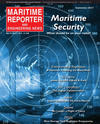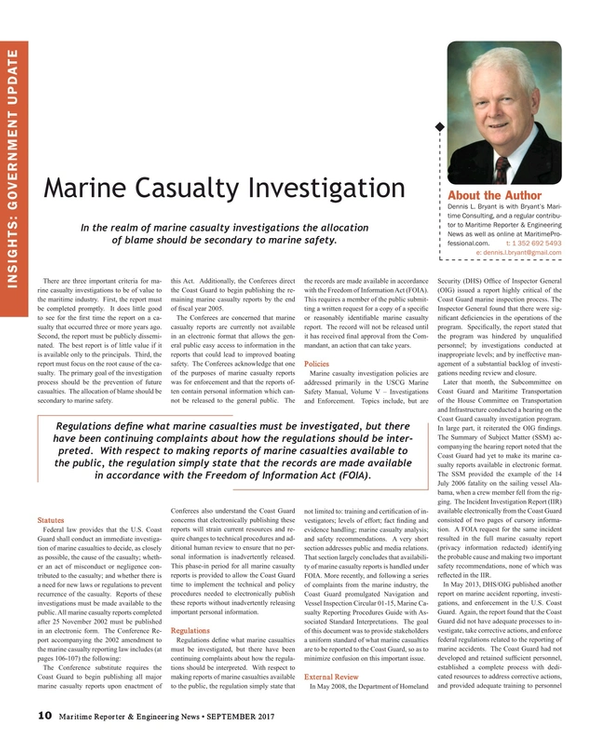
Marine Casualty Investigation
By Dennis Bryant
In the realm of marine casualty investigations the allocation of blame should be secondary to marine safety.
There are three important criteria for marine casualty investigations to be of value to the maritime industry. First, the report must be completed promptly. It does little good to see for the first time the report on a casualty that occurred three or more years ago. Second, the report must be publicly disseminated. The best report is of little value if it is available only to the principals. Third, the report must focus on the root cause of the casualty. The primary goal of the investigation process should be the prevention of future casualties. The allocation of blame should be secondary to marine safety.
Statutes
Federal law provides that the U.S. Coast Guard shall conduct an immediate investigation of marine casualties to decide, as closely as possible, the cause of the casualty; whether an act of misconduct or negligence contributed to the casualty; and whether there is a need for new laws or regulations to prevent recurrence of the casualty. Reports of these investigations must be made available to the public. All marine casualty reports completed after November 25, 2002 must be published in an electronic form. The Conference Report accompanying the 2002 amendment to the marine casualty reporting law includes (at pages 106-107) the following:
The Conference substitute requires the Coast Guard to begin publishing all major marine casualty reports upon enactment of this Act. Additionally, the Conferees direct the Coast Guard to begin publishing the remaining marine casualty reports by the end of fiscal year 2005.
The Conferees are concerned that marine casualty reports are currently not available in an electronic format that allows the general public easy access to information in the reports that could lead to improved boating safety. The Conferees acknowledge that one of the purposes of marine casualty reports was for enforcement and that the reports often contain personal information which cannot be released to the general public. The Conferees also understand the Coast Guard concerns that electronically publishing these reports will strain current resources and require changes to technical procedures and additional human review to ensure that no personal information is inadvertently released. This phase-in period for all marine casualty reports is provided to allow the Coast Guard time to implement the technical and policy procedures needed to electronically publish these reports without inadvertently releasing important personal information.
Regulations
Regulations define what marine casualties must be investigated, but there have been continuing complaints about how the regulations should be interpreted. With respect to making reports of marine casualties available to the public, the regulation simply state that the records are made available in accordance with the Freedom of Information Act (FOIA). This requires a member of the public submitting a written request for a copy of a specific or reasonably identifiable marine casualty report. The record will not be released until it has received final approval from the Commandant, an action that can take years.
Policies
Marine casualty investigation policies are addressed primarily in the USCG Marine Safety Manual, Volume V – Investigations and Enforcement. Topics include, but are not limited to: training and certification of investigators; levels of effort; fact finding and evidence handling; marine casualty analysis; and safety recommendations. A very short section addresses public and media relations. That section largely concludes that availability of marine casualty reports is handled under FOIA. More recently, and following a series of complaints from the marine industry, the Coast Guard promulgated Navigation and Vessel Inspection Circular 01-15, Marine Casualty Reporting Procedures Guide with Associated Standard Interpretations. The goal of this document was to provide stakeholders a uniform standard of what marine casualties are to be reported to the Coast Guard, so as to minimize confusion on this important issue.
External Review
In May 2008, the Department of Homeland Security (DHS) Office of Inspector General (OIG) issued a report highly critical of the Coast Guard marine inspection process. The Inspector General found that there were significant deficiencies in the operations of the program. Specifically, the report stated that the program was hindered by unqualified personnel; by investigations conducted at inappropriate levels; and by ineffective management of a substantial backlog of investigations needing review and closure.
Later that month, the Subcommittee on Coast Guard and Maritime Transportation of the House Committee on Transportation and Infrastructure conducted a hearing on the Coast Guard casualty investigation program. In large part, it reiterated the OIG findings. The Summary of Subject Matter (SSM) accompanying the hearing report noted that the Coast Guard had yet to make its marine casualty reports available in electronic format. The SSM provided the example of the July 14, 2006 fatality on the sailing vessel Alabama, when a crew member fell from the rigging. The Incident Investigation Report (IIR) available electronically from the Coast Guard consisted of two pages of cursory information. A FOIA request for the same incident resulted in the full marine casualty report (privacy information redacted) identifying the probable cause and making two important safety recommendations, none of which was reflected in the IIR.
In May 2013, DHS/OIG published another report on marine accident reporting, investigations, and enforcement in the U.S. Coast Guard. Again, the report found that the Coast Guard did not have adequate processes to investigate, take corrective actions, and enforce federal regulations related to the reporting of marine accidents. The Coast Guard had not developed and retained sufficient personnel, established a complete process with dedicated resources to address corrective actions, and provided adequate training to personnel on enforcement of marine accident reporting. As a result, the Coast Guard has been delayed in identifying the causes of accidents, initiating corrective actions, and providing the findings and lessons learned to mariners, the public, and other government entities. At the time of the report, there were more than 6,000 open marine casualty investigations in the Coast Guard system. A number of the deficiencies identified in the 2013 report had also been identified in the 2008 report.
Practice
The Coast Guard posted a document entitled “Marine Casualty Reports 1904 – 2012”. This 13-page document contains links to 333 marine casualty reports over the 65 year period. One casualty, that of the fatal fire on passenger vessel General Slocum, occurred in 1904.The next oldest report dates from 1947, evidencing a gap of 43 years. Of the remaining 332 reports, 156 occurred in the 1950s.
The document includes a link to the Coast Guard’s MISLE database. This database allows one to search for marine casualties in the IIR file. Such a search though yields cursory information. And it is incomplete.
The most recent of the 333 marine casualty reports linked is that concerning the December 31, 2012 grounding of the MODU Kulluk in Alaska. That 152-page report shows a MISLE activity number of 4509675. If one goes to the MISLE database search page and types in 4509675 in the appropriate spot, the computer states that there is no such activity report. If one types in Kulluk in the vessel name box, the search reveals eight MISLE reports. Unfortunately, none of these concern the December 31, 2012 grounding. Only one of the eight is for a report that directly relates to Kulluk and that is for the accidental discharge of five gallons of hydraulic fluid into Elliot Bay on June 12, 2012. The most recent of the eight MISLE reports is for the November 8, 2012 loss of primary steering by the offshore supply vessel Aiviq in the Arctic Ocean while working the Kulluk’s mooring system.
Each of these reports, like others in the MISLE system, consists of two pages with very limited factual information.
In 1995, an internal Quality Action Team (QAT) analyzed the Coast Guard marine casualty investigations and enforcement program. Changes recommended by the QAT and implemented by the Coast Guard included the hiring of civilian marine casualty investigators and establishment of National Centers of Expertise (NCOEs) for Suspension and Revocation (S&R NCOE) and Investigations (INV-NCOE). It is difficult to determine how much improvement there has been subsequently in the marine casualty investigation and reporting process since complete marine casualty reports seldom are publicly posted.
Recommendations
The Coast Guard should devote more effort toward completion of marine casualty investigations in a timely manner. Part of the problem is undoubtedly due to resource constraints, but a significant issue is the entire lack of any direction or guidance placing an emphasis on timeliness. The Coast Guard should also get its reports of marine casualty investigations posted on the Internet immediately after final action has been taken by the Commandant. New reports should be written so that privacy information (such as names and addresses) is in a separate appendix. Old reports should be redacted prior to posting, but the redaction should be accomplished in a timely manner. Quality control efforts should be continued so as to ensure that marine casualty investigations and the reports of same accomplish their principal purpose: enhancement of marine safety.
(As published in the September 2017 edition of Maritime Reporter & Engineering News)
Read Marine Casualty Investigation in Pdf, Flash or Html5 edition of September 2017 Maritime Reporter
Other stories from September 2017 issue
Content
- Marine Casualty Investigation page: 10
- The Art of Navigation page: 14
- The Nautical Safety Profile page: 14
- Ocean Guardian: Simplifying Environmental Compliance page: 16
- LNG: Maritime's 'Fuel of the Future' page: 20
- USCG Releases Draft Cyber Guide for Maritime Facilities page: 28
- Data Analytics in the Maritime Space page: 29
- Inside the USS Gerald R. Ford page: 30
- Aerial Drones Take Flight in Maritime page: 38
- FPSOs: New Storage Tank Explosion Frequencies page: 42
- Interferry Mission: Strength from Unity page: 46


